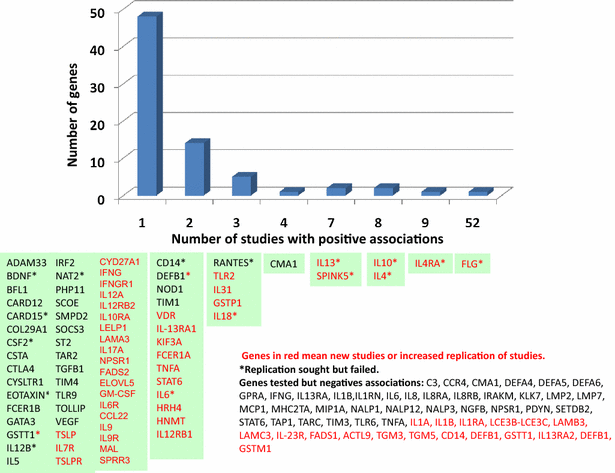Genetic and epigenetic studies of atopic dermatitis
- PMID: 27777593
- PMCID: PMC5069938
- DOI: 10.1186/s13223-016-0158-5
Genetic and epigenetic studies of atopic dermatitis
Abstract
Background: Atopic dermatitis (AD) is a chronic inflammatory disease caused by the complex interaction of genetic, immune and environmental factors. There have many recent discoveries involving the genetic and epigenetic studies of AD.
Methods: A retrospective PubMed search was carried out from June 2009 to June 2016 using the terms "atopic dermatitis", "association", "eczema", "gene", "polymorphism", "mutation", "variant", "genome wide association study", "microarray" "gene profiling", "RNA sequencing", "epigenetics" and "microRNA". A total of 132 publications in English were identified.
Results: To elucidate the genetic factors for AD pathogenesis, candidate gene association studies, genome-wide association studies (GWAS) and transcriptomic profiling assays have been performed in this period. Epigenetic mechanisms for AD development, including genomic DNA modification and microRNA posttranscriptional regulation, have been explored. To date, candidate gene association studies indicate that filaggrin (FLG) null gene mutations are the most significant known risk factor for AD, and genes in the type 2 T helper lymphocyte (Th2) signaling pathways are the second replicated genetic risk factor for AD. GWAS studies identified 34 risk loci for AD, these loci also suggest that genes in immune responses and epidermal skin barrier functions are associated with AD. Additionally, gene profiling assays demonstrated AD is associated with decreased gene expression of epidermal differentiation complex genes and elevated Th2 and Th17 genes. Hypomethylation of TSLP and FCER1G in AD were reported; and miR-155, which target the immune suppressor CTLA-4, was found to be significantly over-expressed in infiltrating T cells in AD skin lesions.
Conclusions: The results suggest that two major biologic pathways are responsible for AD etiology: skin epithelial function and innate/adaptive immune responses. The dysfunctional epidermal barrier and immune responses reciprocally affect each other, and thereby drive development of AD.
Keywords: Adaptive immunity; Atopic dermatitis; DNA methylation; Epigenetic; Genetic association; Genetics; Innate immunity; Skin barrier; miRNA.
Figures


References
-
- Sneddon IB. The management of infantile eczema. Med Press. 1951;226(14):329–333. - PubMed
Publication types
Grants and funding
LinkOut - more resources
Full Text Sources
Other Literature Sources
Medical
Miscellaneous

